Madrid in a day I
Madrid is the most beautiful city in the whole wide world. Or at least that's what I think.
Despite my biased view towards it, it's true that Madrid is one of the most beautiful and most visited cities in the world. It isn't just me that says this either, but almost every tourist guide that I've read about this magnificent city.
Unlike my visit to Paris, in which I took a tour that showed you most of the city in 7 hours (read Paris in 7 hours), to visit Madrid you're going to need a few more hours, and possibly a whole day.
In this post, I'm going to talk to you about Madrid's most famous landmarks, as well as the lesser known places that only someone born and bred in Madrid (like me) knows about.
To begin, I'd recommend you do a little tour around the centre of the city (before heading to the outskirts of Madrid). This will take you between 4 and 5 hours, taking breakfast and dinner into account of course.
I recommend starting your journey in the district of Moncloa. I'd get going quite early at about 9am to make the most of the day.
In Moncloa you'll find the metro and bus station, so if you're not staying within walking distance, you can always get the metro.
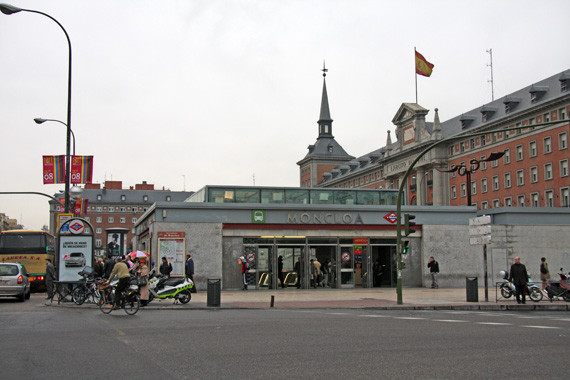
Normally, the price of a ticket is 1 euro and 50 cents or 1 euro and 70 cents, depending on how far away your destination station is.
If you're going to stay in Madrid for about 5 days and you're someone who likes to move around alot, I recommend you take a look at the ticket which gives you ten journeys.
You can get vouchers for the metro, the bus and even Renfe (a Spanish train company), but prices vary quite a bit.
If you also want to go to Toledo or El Escorial as well as Madrid, then I recommend you get a Renfe ticket because there is no metro line to these areas.
Anyway, let's get back to Moncloa.
Once you have risen to the surface after exiting the underground metro, you will find yourself right in front of the Air Force Headquarters, known as the Ministry of Air. (or the Ministry of Magic as I like to call it).
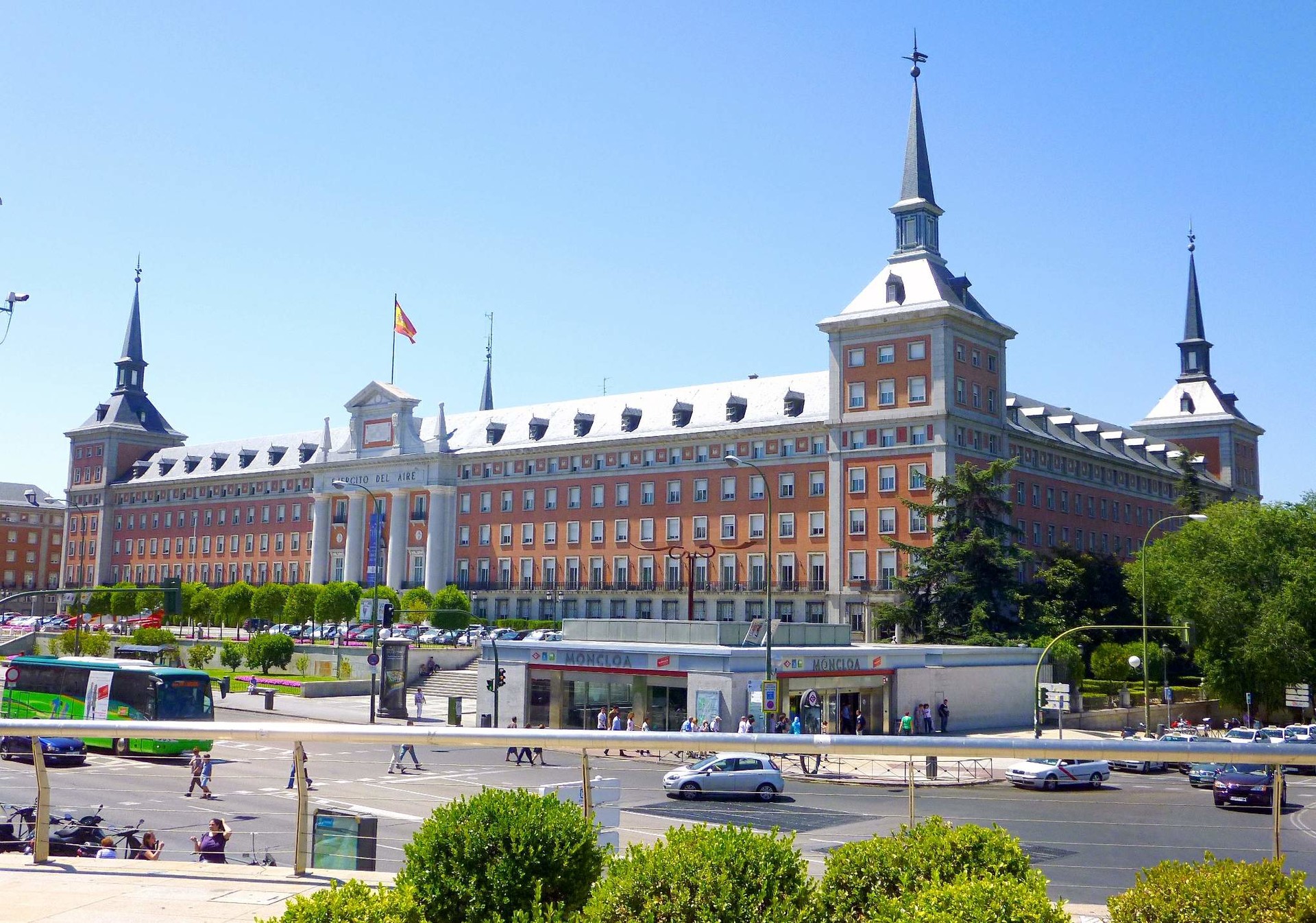
In my opinion, the building's displays some brillaint and impressive architecture.
If you want, you can take a look around inside from 11am to 8pm. Though personally I think the building's exterior is its best feature, you won't miss out by not seeing inside.
I met up with some friends there once, and coincidently, there were veteran soldiers were taking part in a march and a small market displaying things from the army, police, and firefighting service.
There were bulletproof vests, helmets and riot gear batons which they let you try on, as well as guns and machine guns (obviously unarmed).
But the best thing was the soldiers who did small demonstrations and helped people put on the riot suits. At that moment I understood why women all over the world swoon over Spanish men, because these soldiers looked like supermodels.
Another interesting thing about Moncloa is its lighthouse, el faro de la Mocloa, or "the mushroom" as we locals call it. This lighthouse is an icon of the city of Madrid.
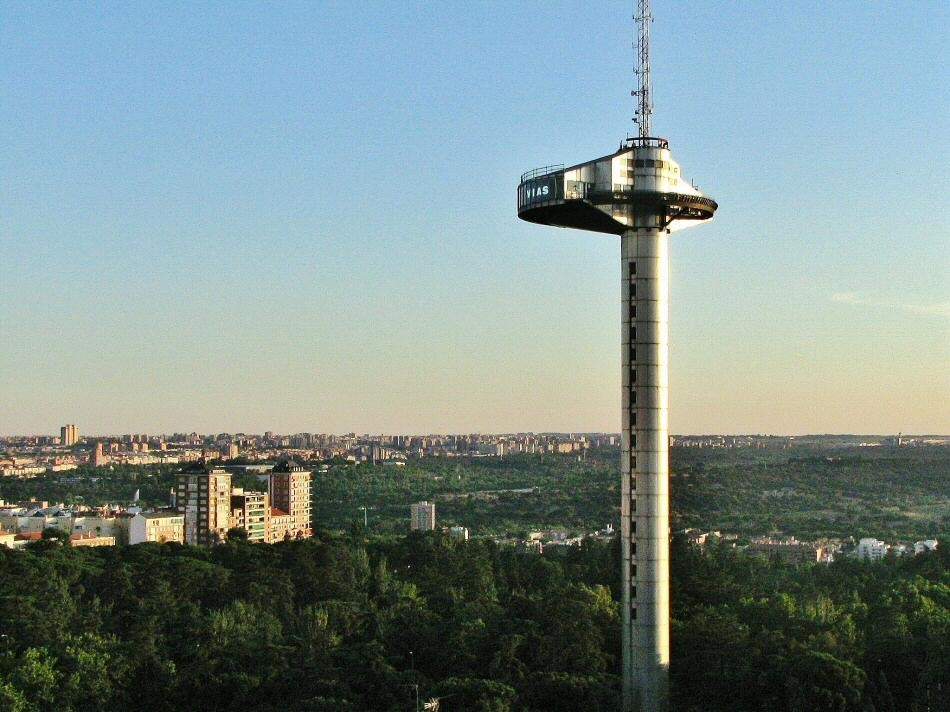
This lighthouse is a lighting and communication tower standing about 110 meters high and located next to Moncloa and the University City (Ciu).
At the top of the lighthouse there is a huge viewing platform where you can see all of Madrid's most famous and historical monuments. A magical panorama.
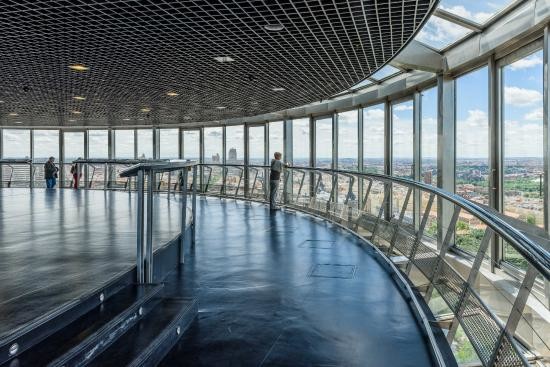
To get to the viewing platform, you have to take a panoramic lift which lets you see the view as you ascend towards the sky. This is were the famous motto of my city, from Madrid to heaven, comes from. Truer words have never been spoken.
Admission costs 3 euros and it is open from Tuesday to Sunday (it's closed on Mondays! ) from 9:30am to 8pm, although the last ascent is at 7:30.
The visit lasts for a maximum of 30 minutes and you up in groups of 15 (maybe less, I don't remember exactly).
You can come back down whenever you want, you don't have to wait for the full 30 minutes. However, seeing as you've paid to get up there, I recommend you to stay as long as possible and enjoy the views because there is so much to see.
Near the windows of the viewing platform, there are to-scale replicas of some of the most famous buildings in Madrid that you can see from the lighthouse.
From the viewing platform you can see the big building on Plaza de España, the Royal Palace, the cemetery of San Isidro and the Palacio de Cibeles, as well as many others.
Aside from the replicas, there are also explanations of each building in both Spanish and English.
You definitely can't miss out on seeing Madrid from the sky.
After seeing Moncloa, the next place to go is Plaza de España. To get there, just walk for 10 minutes along Princesa Street, the city's financial district.
In this street you will find most of Madrid's banks, as well as lots of buildings which are exclusively for business offices.
There is also a huge Corte Inglés departement store and a church known as the Parroquia de Nuestra Señora del Buen Suceso.
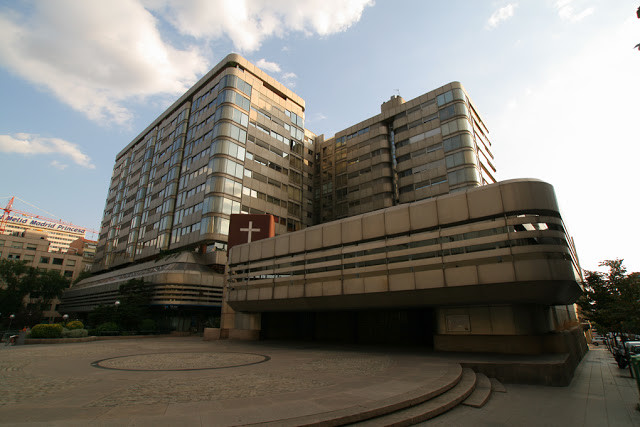
After the church, you'll find Cubos.

This is a little square which has a monument shaped like cubes (this is where the name comes from), and fast-food restaurants like Macdonalds, Burger King and Taco Bell.
But this isn't all there is to Cubos. There is also a cinema complex called Cines Princesa or Cines Renoir, which is located in a tunnel underneath the square.
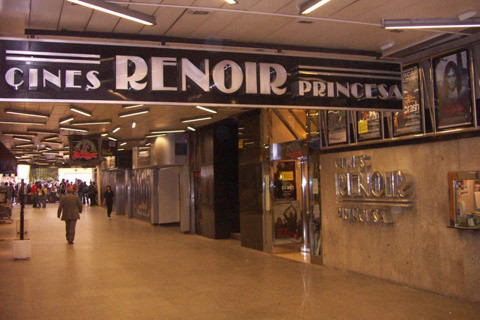
This cinema is known for showing lesser known independent films, mostly from Europe. The original version is screened with Spanish subtitles.
There is another Cine Renoir in Madrid, but it's far from the city centre in Majadahonda. If you can catch the number 627 or 626 bus from Moncloa, you can get there in about an hour or so.
The thing I like most about Cines Renoir is that they screen the orginal version of really good films with spanish subtitles, and it's very rarely jam-packed.
Anyway, just a little further on from Cubos, you'll find the super famous Plaza de España.
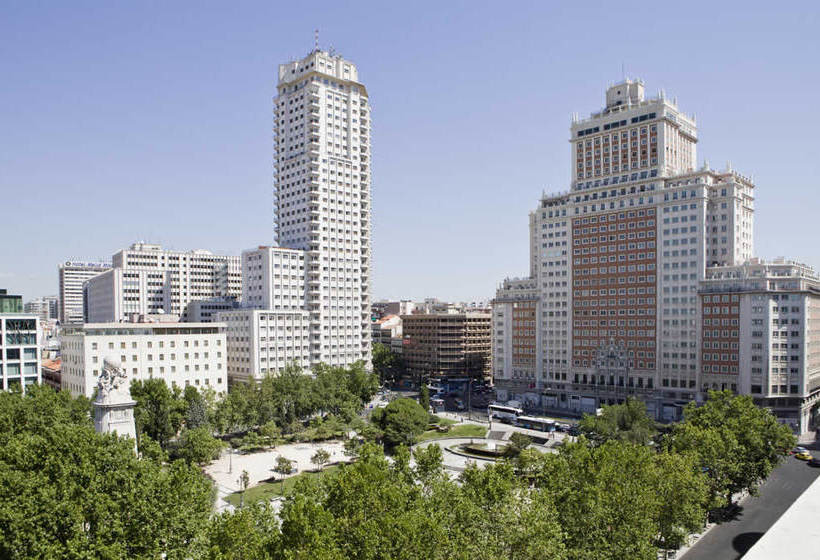
This square isn't well-known solely for the square itself (even though it's magnificent), but also for the famous building which frame it.
As I understand it, the white building is full of offices, and the other one was bought by the Chinese and converted into luxury flats.
In the square you'll find a really beautiful large fountain which sometimes you can see people happily washing in, as if they were washing at home (you'd normally see this in summer).
During the winter, a Christmas market is normally put in the square with stalls that sell artisan products.
Not many people know this, but behind the square you can find an iconic Spanish monument depicting Don Quijote and Sancho Panza. They are represented by Don Quijote's horse, Rocinante, and Sancho Panza's donkey, Rucio.

This monument is a well-kept sectret as people usually walk along the front of the square and just take pictures in front of the fountain - they don't know that Don Quijote de la Mancha is right behind them.
The square itslef is filled with grassy areas where you can sit and sunbathe when the weather is good enough.
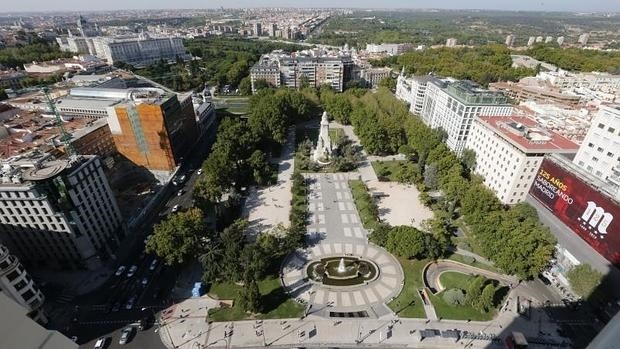
Amongst the locals, Plaza de España is known as "the Emo spot". This is because all the Emo's in Madrid gather at the metro exit in the square to share their sorrows and chat with each other.
After spending some time in the square, they tend to go down to the underground part of the square. Here you'll find a Chinese restaurant and a Chinese bazaar where you can buy instant ramen - they also give you the hot water and chopsticks so you can eat them there and then.
I can't say much about the restaurant because I have never eaten there, although I've been told that it isn't bad for the price you pay.
Almost every time I go, it's full, so I think that's why I haven't been there yet.
After hanging out in the square, the Emo kids go to Templo Debod, a rescued Egyptian temple, which is right next to Plaza España. However, I recommend you go a bit later as the sun is setting because it's quite beautiful. There's also a small viewing point where you can watch the sun hide behind the city's buildings.

If we continue along our route, we come to Madrid's famous Gran Vía.
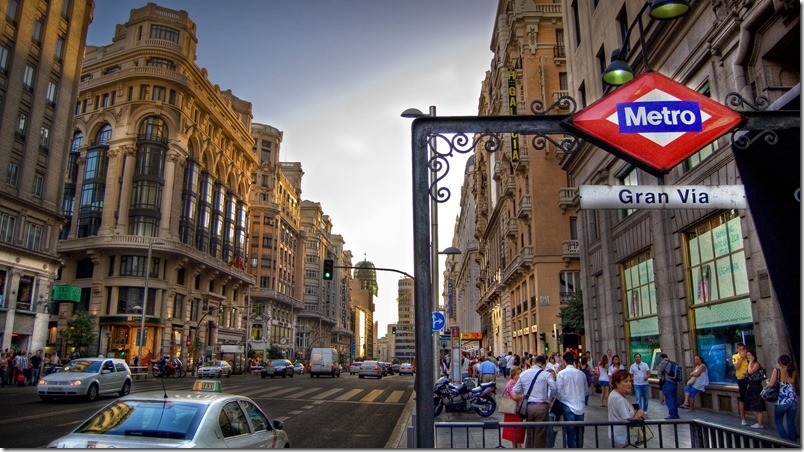
It's a little bit like Broadway, but Spanish style.
It's always full of people, sometimes it's so busy it's impossible to take two steps without having to stop.
If you're hungry, you can find lots of different restaurants and cafés in Gran Vía where you can stop to eat (though they're very expensive). But I'd suggest not giving in to your hunger just yet, because further on you'll find a brilliant place to have a second breakfast.
In Gran Vía you'll also find big shops like Mango, Sfera, H&M, Zara or Primark (the biggest Primark in the world).
This shop is nuts. It's always packed with people, so much so that sometimes you have to queue to get in, especially during the sales and during Christmas.
An super well-known American restaurant has just been opened further along Gran Vía - Five Guys. They make the best hamburgers plus you can eat as many peanuts as you like for free.
There's also a TGI Friday, although personally I think it seems a bit pricey considering the types of things they offer and the quality of the food.
For lovers of sushi and Japanese food, Gran Vía is full of Japanese restaurants There's Sumo, Oishii, Sumosan, Nigiri, Yakitori, Hattori Hanzo and many others. I've eaten in all these places and all of them were fantastic.
Just as you get to Five Guys, you'll see that you're in some sort of tiny square with big screens.
This place is called Callao and it's where you'll find the cinema "Callao". You'll also find the most popular and most frequented Starbucks in Madrid and the Fnac, as well as one of the most famous billboards in Madrid: Schweppes.
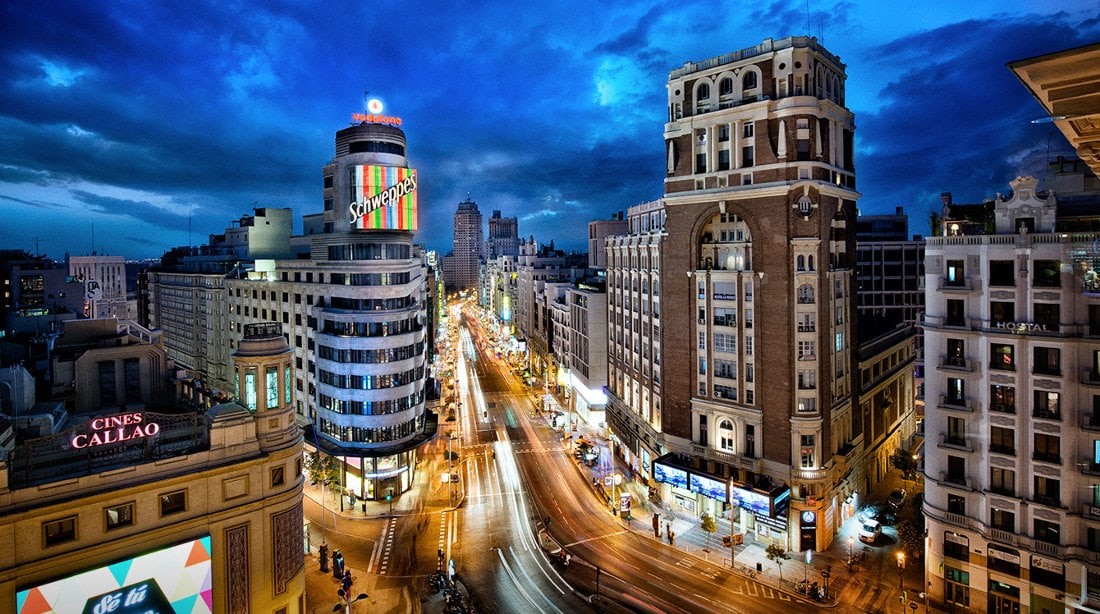
The Fnac is a good place to take refuge during the blistering summer heat, because the air conditioning is always on full blast - something which is often appreciated.
Let's leave Gran Vía, cross la plaza de Callao and join calle Preciados, where you'll see lots of street musicians who I think are very talented.
This street is relatively short if you compare it to Gran Vía, and once you reach the end of it you'll find another famous part of Madrid, Puerta de Sol.
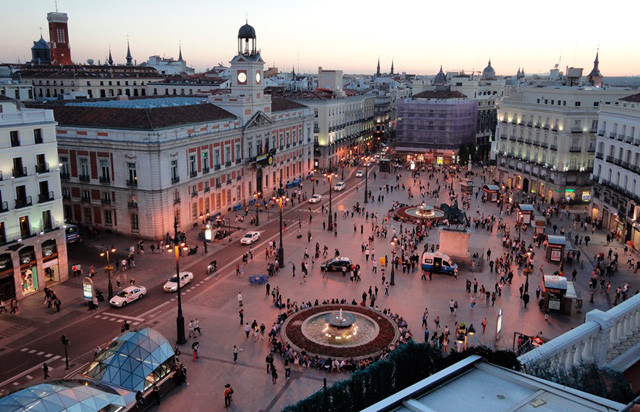
Puerta de Sol is perhaps the most well-known part of Madrid after Gran Vía (and maybe El Retiro park).
This enormous square is the sundial of the city. The statue of the bear and the strawberry tree is the symbol of Madrid, the "kilometre zero" of Spain's radial roads, representing the symbolic centre of the country.
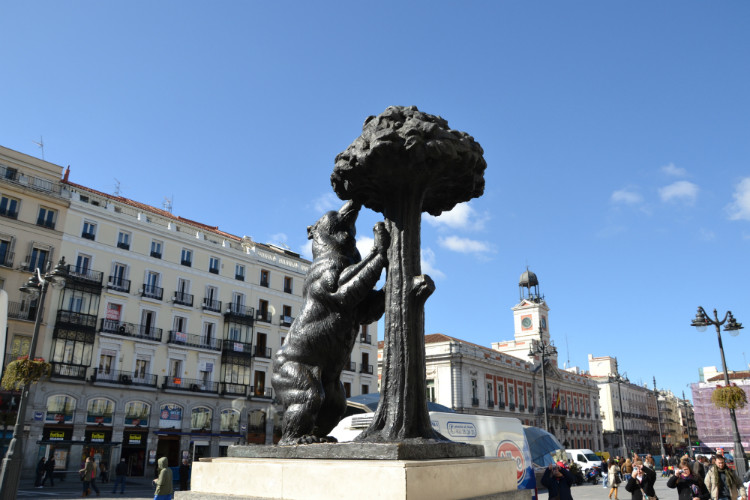
This is, without a shadow of a doubt, a really emblematic place for the people of Madrid.
This large square is always full of people dressed up as cartoon characters such as the Simpsons, Mister Bean, Pocoyo or Dora the Explorer.
I hate these people because sometimes they can be super insistent that you have your picture taken with them and then pay them for it. It's a pain in the neck and it actually bothers me quite a lot because every day there are more and more of them about.
However, you can also find other street artists such as mimes, magicians, or dancers putting on a show in the middle of the square.
Furthermore, in this square there is the most beautiful metro exit in Madrid (at least I think so). It has two glass canopies that, when seen from the air, are shaped like a fish.

This metro exit is also usually filled with Emos, just like the one in Plaza de España. However, these are older, not the typical teenagers found in Plaza de España.
As I said before, the monument of the Bear and the strawberry tree is in this Square. Any person from Madrid who's worth his salt will know about this landmark.
You'll always see a group of tourists trying to take a decent picture in front this monument.
However, for the Spaniards, this square is known as the square where you eat your end-of-year grapes.
For those who are not Spanish, I can tell you that in Spain we have a very interesting tradition, which consists of eating 12 grapes on each of the twelve strikes of the bell on December 31/January 1.
Loads of people gather at the Puerta de Sol, because there's a clock that will ring out the bells to welcome in the new year.
Those who cannot go to Puerta de Sol, can always watch the live broadcast of the bells from any television or internet channel from their home, a bar or a restaurant. Wherever they are, they can watch it.
I think it's a fantastic tradition in my opinion, and there's never a year where a family member ends up choking on a grape or is unable to eat eat all twelve.
They say that if you manage to eat all twelve grapes (one at each strike of the bell), they'll have good luck throughout the year. And I can testify to that.
Besides the bear and the strawberry tree, there is another famous monument in Puerta de Sol - the statue of King Charles III of Spain on his horse.
In Madrid there are a total of three statues dedicated to this king, but only in the Plaza de Puerta de Sol does he appear riding a horse.
The horse is an important part of the monument. The position of the horse's legs reveal how its rider died.
If the statue of the horse has two front legs raised or in the air, this means that the person died in combat.
On the other hand, if the horse appears with all four legs touching the ground, then the person died of natural causes.
In the case of King Charles III of Spain, one of the horse's legs is raised, meaning he died due to his battle wounds.
Finally, another interesting thing about Puerta del Sol which I mentioned earlier, is the fact that it isthe "zero kilometre" of Spain's radial roads.
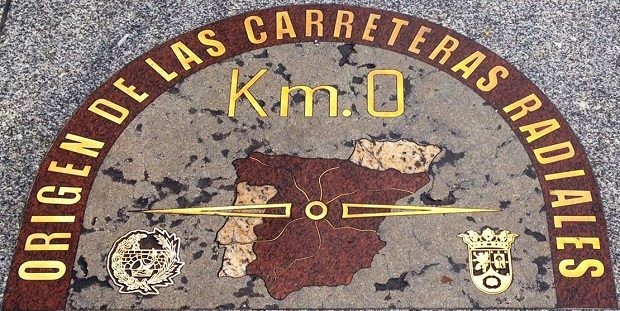
The construction of all of Spain's roads began at this very point.
Just as there is at the statue of the Bear and the strawberry tree, you will notice there's always a huddle of poeple around this point trying to take a picture.
Just a heads up, the Puerta de Sol is located just in front of the clock tower, so you'll have to cross a small road.
If there aren't any tourists around, it may be difficult for those who haven't been before to find. So, when you are in the square, near the McDonald’s, look at the ground and there you'll find the tile with kilometer zero written on it.
Did you know that the Christmas market that they set up in Plaza Mayor is one of the best Christmas markets in Europe?
Photo gallery
Content available in other languages
- Español: Madrid en un día I
- Français: Madrid en une journée I
- Italiano: Madrid in un giorno I
Want to have your own Erasmus blog?
If you are experiencing living abroad, you're an avid traveller or want to promote the city where you live... create your own blog and share your adventures!
I want to create my Erasmus blog! →
































Comments (0 comments)